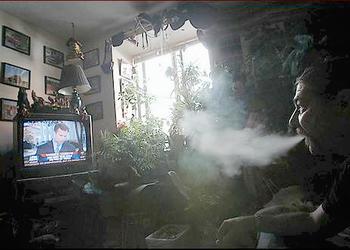
BERKELEY, California, June 21, 2013 (ENS) – For the first time, scientists have documented that thirdhand smoke – the noxious residue that clings to virtually all surfaces long after the secondhand smoke from a cigarette has cleared out – causes genetic damage in human cells.
Humans can be exposed to thirdhand smoke through inhalation, ingestion or skin contact.
“This is the very first study to find that thirdhand smoke is mutagenic,” said Lara Gundel, a Berkeley Lab scientist and co-author of the study.

“Tobacco-specific nitrosamines, some of the chemical compounds in thirdhand smoke, are among the most potent carcinogens there are,” said Gundel. “They stay on surfaces, and when those surfaces are clothing or carpets, the danger to children is especially serious.”
The study led by researchers from Lawrence Berkeley National Laboratory also found that chronic exposure over time is worse than acute exposure, a single exposure lasting less than a day.
Suggesting that the smoke residue becomes more harmful over time, the scientists found that the chemicals in samples exposed to chronic thirdhand smoke existed in higher concentrations and caused more DNA damage than samples exposed to acute thirdhand smoke,
Their paper, “Thirdhand smoke causes DNA damage in human cells,” is published in the current issue of the journal “Mutagenesis.”
The researchers used two common in vitro tests to examine the samples for genotoxicity. They found that thirdhand smoke can cause both DNA strand breaks and oxidative DNA damage, which can lead to gene mutation.
Genotoxicity is associated with the development of diseases and is a critical mechanism responsible for many types of cancer caused by smoking and secondhand smoke exposure.

“Until this study, the toxicity of thirdhand smoke has not been well understood,” said lead investigator Bo Hang, a biochemist in the Life Sciences Division of Berkeley Lab.
“Thirdhand smoke has a smaller quantity of chemicals than secondhand smoke, so it’s good to have experimental evidence to confirm its genotoxicity,” he said.
Thirdhand smoke is particularly insidious because it is extremely difficult to eradicate. Studies have found that it can still be detected in dust and surfaces of apartments more than two months after smokers moved out.
Common cleaning methods such as vacuuming, wiping and ventilation have not proven to be effective in lowering nicotine contamination.
“You can do some things to reduce the odors, but it’s very difficult to really clean it completely,” said Hugo Destaillats, a chemist from Berkeley Lab’s Environmental Energy Technologies Division who participated in this study. “The best solution is to substitute materials, such as change the carpet, repaint.”
The new study suggests thirdhand smoke could become more and more harmful over time.
To generate the samples, the researchers put paper strips in smoking chambers. The acute samples, generated at Berkeley Lab, were exposed to five cigarettes smoked in about 20 minutes.
The chronic samples, generated at the University of California, San Francisco, were exposed to cigarette smoke for 258 hours over 196 days. During that time, the chamber was also ventilated for about 35 hours.
The researchers found that the concentrations of more than half of the compounds studied were higher in the chronic samples than in the acute samples. They also found higher levels of DNA damage caused by the chronic samples.
“The cumulative effect of thirdhand smoke is quite significant,” Gundel said. “The findings suggest the materials could be getting more toxic with time.”

Studies from Berkeley Lab conducted in 2010 found that residual nicotine can react with ozone and nitrous acid, both common indoor air pollutants, to form hazardous agents.
When nicotine in thirdhand smoke reacts with nitrous acid it undergoes a chemical transformation and forms carcinogenic tobacco-specific nitrosamines.
Nicotine can react with ozone to form ultrafine particles, which can carry harmful chemicals and pass through human tissue.
During the study, Hang and his coworkers exposed the human cells by first extracting the compounds from the paper with a culture medium then using the medium to culture the human cells for 24 hours. The concentrations of the compounds were then measured.
“They are close to real-life concentrations, and in fact are on the lower side of what someone might be exposed to,” Hang said.
Next Hang is pursuing further understanding of NNA, a tobacco-specific nitrosamine that is not found in freshly emitted secondhand smoke.
“It looks like it’s a very important component of thirdhand smoke, and it is much less studied than NNK and NNN in terms of its mutagenic potential,” he said.
The researchers conclude, “Ultimately, knowledge of the mechanisms by which thirdhand smoke exposure increases the chance of disease development in exposed individuals should lead to new strategies for prevention.”
This is the first major study of disease-related mechanisms to come out of the California Consortium on the Health Effects of Thirdhand Smoke, established two years ago largely as a result of work published in 2010 by Gundel among others.
The Consortium is funded by the Tobacco-Related Disease Research Program, which is managed by the University of California and funded by state cigarette taxes.
Copyright Environment News Service (ENS) 2013. All rights reserved.
© 2013, Environment News Service. All rights reserved. Content may be quoted only with proper attribution and a direct link to the original article. Full reproduction is prohibited.
